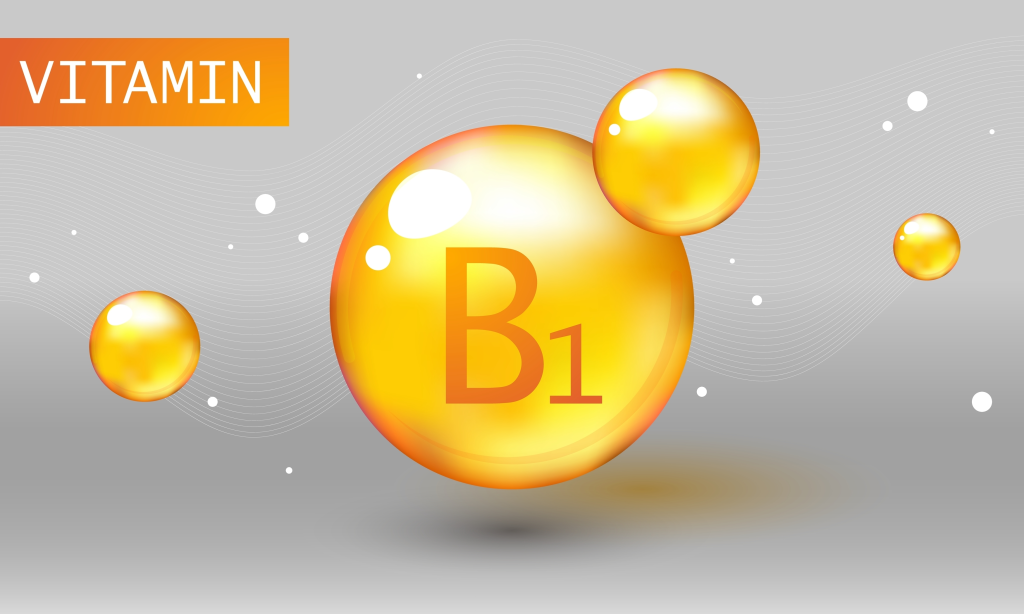At a glance
Several underlying factors, including nutrient deficiencies, hormonal shifts, and age-related changes in nervous system function, may contribute to the development of restless leg syndrome. Supporting healthy nutrient levels, quality sleep, and overall nervous system health may help promote leg comfort and more restful sleep.
Restless leg syndrome is a neurological motor sensory disorder characterized by involuntary muscle movement and muscle spasms, often at night, which can cause difficulties falling asleep.
Vitamin B1 deficiency is one of the most common but often overlooked causes of restless leg syndrome, leaving many affected struggling with persistent uncomfortable sensations and sleep issues.
Discover the best dietary sources of vitamin B1 to support healthy neurological functions and learn about simple but effective ways to manage and prevent restless leg syndrome.
What is RLS (restless leg syndrome)?
Restless leg syndrome (RLS), also referred to as periodic limb movement disorder or Willis-Ekbom disease, is a neurological disorder that causes an irresistible urge to move the legs.
RLS symptoms are typically most noticeable during periods of rest or inactivity, often in the evening or at night.
This can lead to significant sleep disturbance and explain why RLS is also classified as a sleep disorder and a leading cause of insomnia and poor sleep quality.
Research published in the Journal of Global Health shows that RLS is fairly common, affecting around ten percent of the world’s population.1
The authors also highlight that RLS symptoms occur more likely in women than men and that older individuals, smokers, and those with diabetes and depression are at increased risk of developing this condition.
While it’s believed that RLS development is partially linked to an age-related decline in spinal cord integrity and neurological function, nutritional deficiencies and hormonal imbalances have also been implicated.
Watch the video below to learn more about the common causes of RLS.
Symptoms of restless leg syndrome
In most cases, RLS symptoms begin with unpleasant sensations in the legs, including tingling, crawling, or aching, that can create an irresistible urge to move or fidget to stop the discomfort.
These symptoms usually appear during periods of rest and can make it difficult to fall asleep or stay asleep.
Some people experience only mild RLS symptoms that don’t significantly affect their quality of life. However, more severe cases can lead to daytime sleepiness due to poor rest or the need for sleep medicine, which often causes brain fog and drowsiness the next day.
While a RLS diagnosis isn’t inherently dangerous, it’s crucial to consult a healthcare professional if you develop symptoms to rule out other potential causes, such as nerve damage or Parkinson’s disease.

Causes of restless leg syndrome
RLS is classified into primary and secondary forms, depending on the exact underlying cause.
Secondary RLS develops due to another medical condition, such as kidney failure or rheumatoid arthritis, and can also be triggered by certain medications. These include drugs used to treat Parkinson’s disease as well as depression and other mood disorders.
In contrast, many cases of primary RLS result from poor nervous system functions, often linked to a lack of vitamin B1, which plays a crucial role in maintaining healthy nerve cells and neuronal tissue.
Vitamin B1 deficiency can lead to peripheral neuropathy, which is the gradual damage or dysfunction of nerves. This often results in tingling, burning, or restless sensations in the legs, which can trigger and worsen RLS symptoms.
Vitamin B1 is also needed to produce and release the brain chemical dopamine, which controls movement and neuronal sensory processing.
A report published by the National Institutes of Health (NIH) suggests that dopamine imbalances can disrupt normal muscle activity and trigger involuntary movements such as those seen in RLS.2
Furthermore, iron deficiency, especially in brain tissue, has been found to contribute to RLS and may make symptoms worse by impacting how neurons respond to dopamine.
Research published in Frontiers in Molecular Neuroscience summarizes, “Iron is an essential micronutrient for the regulation of dopaminergic neurotransmission. Insufficient dietary iron supply can establish molecular features that resemble several neurological disorders.”3

What helps relieve restless leg syndrome?
Beneficial dietary and lifestyle changes are important to address the root causes of RLS and effectively relieve symptoms.
Here are two simple but effective steps to manage RLS.
1. Prioritize vitamin B1-rich foods
Because of its crucial role in supporting a healthy nervous system, maintaining optimal vitamin B1 levels with nutrient-rich whole foods is vital to managing RLS.
Some of the best sources of vitamin B1 include:
- Pork
- Salmon
- Flax seeds
- Eggs
- Beef liver and other organ meats
- Mussels and clams
- Sunflower seeds
- Green peas
- Edamame
- Tofu
- Walnuts
- Acorn squash

2. Maintain optimal iron levels
“Maintaining healthy iron levels is particularly important for women, who are at a higher risk of both iron deficiency and RLS,” explains Dr. Berg.
Iron can be found in a wide range of plant and animal-based foods. However, the heme-iron form found in animal products is significantly better absorbed and bioavailable than non-heme iron in plant foods.
This leaves vegans and vegetarians at increased risk of deficiency and may contribute to RLS symptoms in those not consuming enough dietary iron.
Top sources of highly bioavailable iron include:
- Clams
- Oysters
- Red meat
- Oily fish
- Eggs
- Organ meat
- Mussels
- Octopus
Combining vitamin C-rich foods such as bell peppers, broccoli, or cabbage with iron-rich foods is an excellent strategy for enhancing intestinal iron absorption and promoting healthy levels of this essential mineral.

Preventing RLS symptoms
In addition to maintaining optimal vitamin B1 and iron levels, supporting restful sleep, engaging in moderate exercise, and following a low-carb diet can help manage and prevent RLS symptoms.
Here are three ways to support a healthy central nervous system.
1. Follow Healthy Keto®
Evidence published in Current Developments in Nutrition highlights that diets high in carbs and sugars are linked to an increased risk of vitamin B1 deficiency.4
Vitamin B1 is required for carbohydrate metabolism, which explains why a high-carb diet can contribute to depletion and deficiency.
Healthy Keto® is an ideal meal plan for supporting nervous system health. This optimized version of the ketogenic diet minimizes carbohydrate intake while emphasizing nutritious whole foods rich in nutrients needed for optimal neuronal functions, including vitamin B1 and iron.
2. Prioritize good sleep habits
While RLS can interfere with sleep, poor sleeping patterns can also contribute to or worsen RLS symptoms.
Lack of adequate sleep can dysregulate nervous system functions and cause imbalanced dopamine release, two key factors in the development of RLS.
Prioritizing sleep quality by establishing a consistent bedtime, limiting screen time before bed, and creating a relaxing nighttime routine can help ease RLS symptoms and support overall nervous system health.
3. Stay physically active
Moderate exercises such as walking, swimming, and cycling have been found to benefit affected individuals, especially those with mild symptoms of RLS.
Staying physically active can help maintain healthy circulation, support nerve function, and reduce restlessness, especially during periods of inactivity or in the evening when RLS symptoms tend to worsen.

When to talk to your doctor
If you suddenly develop RLS or experience worsening symptoms, it’s crucial to consult a medical provider for a comprehensive evaluation of your health.
To diagnose RLS, a doctor will likely discuss your medical history, perform a physical exam, and order blood tests to assess iron levels and rule out possible underlying chronic diseases that may contribute to symptoms.
First-line treatment in clinical practice depends on how severe RLS symptoms are and typically includes dietary and lifestyle changes.
In some cases, medications to support dopamine balance, anti-seizure drugs, or iron replacement therapy may be considered to treat RLS under medical supervision.
Key takeaways
- Restless leg syndrome (RLS) is a neurological condition characterized by an irresistible urge to move the legs, often associated with nutrient deficiencies, hormonal imbalances, and age-related changes in nervous system function.
- High-carb diets, poor sleep, and certain medications can worsen RLS by influencing nutrient levels, dopamine activity, nervous system health, and metabolic function.
- Vitamin B1 deficiency and low iron levels are two of the most common contributors to RLS, as both nutrients play key roles in maintaining healthy neurological and sensory motor function.
- Prioritizing vitamin B1- and iron-rich foods, engaging in physical activity, practicing healthy sleep habits, and following a nutrient-dense, low-carb diet, such as Healthy Keto, may help improve nighttime comfort and promote more restful sleep.
FAQ
1. What’s the number one cause of restless leg syndrome?
Vitamin B1 deficiency is an often overlooked but common cause of restless leg syndrome.
Because vitamin B1 plays a critical role in maintaining a healthy nervous system, lack of this essential nutrient can trigger or worsen the irresistible urge to move the legs.
2. What triggers restless leg syndrome?
Common triggers of restless leg syndrome include vitamin B1 deficiency, iron deficiency, sleep apnea, and a lack of adequate sleep.
In addition, restless leg syndrome can develop as a result of hormonal imbalances or underlying health issues, such as peripheral neuropathy, diabetes, or rheumatoid arthritis.
3. What relieves restless legs fast?
Supporting the body’s nutritional needs with foods rich in vitamin B1 and iron can help relieve restless leg syndrome symptoms fast, particularly in cases linked to nutrient deficiencies.
Foods such as organ meat, red meat, eggs, and mussels are all excellent sources of both iron and vitamin B1 and should be regularly consumed by those seeking to manage restless leg syndrome.
4. Does walking help with restless leg syndrome?
Yes, moderate exercises such as walking, swimming, and cycling can help ease symptoms of restless leg syndrome.
Physical activity supports circulatory health and neurological functions, which are key factors for preventing involuntary muscle movements.
Sources
- https://pmc.ncbi.nlm.nih.gov/articles/PMC11156251/ ?
- https://www.ninds.nih.gov/health-information/disorders/restless-legs-syndrome ?
- https://pmc.ncbi.nlm.nih.gov/articles/PMC5434142/ ?
- https://pmc.ncbi.nlm.nih.gov/articles/PMC8265441/ ?


















